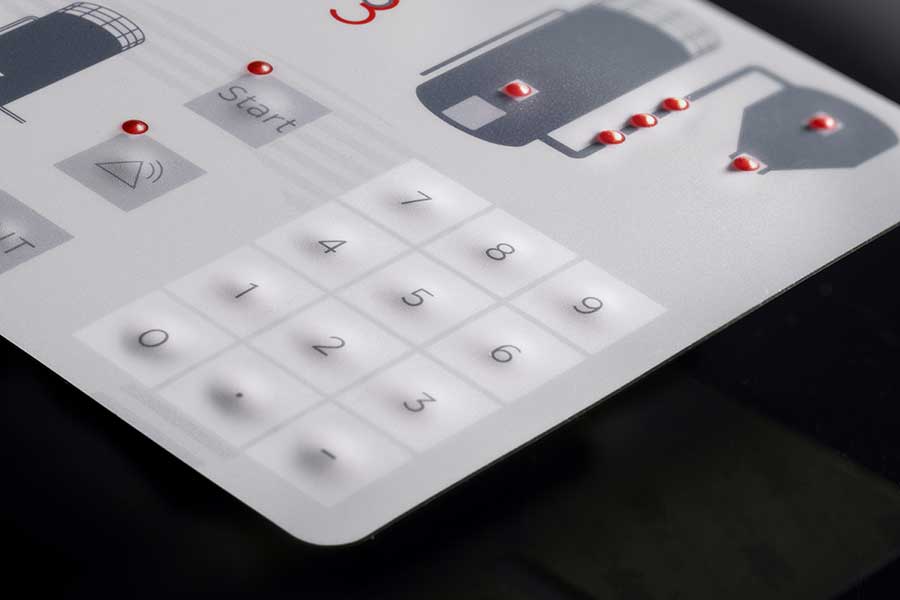Why Membrane Layer Changes Are Necessary for Long Lasting Control Systems
Membrane switches play a pivotal duty in making sure the sturdiness and reliability of control systems across numerous markets. Their special building allows them to sustain tough environmental aspects such as moisture, temperature extremes, and physical wear. This strength not only extends the life-span of the systems they offer but also lessens upkeep demands. As we explore the multifaceted benefits of membrane layer buttons, it comes to be noticeable that their significance transcends mere performance, influencing individual experience and functional efficiency. What additional ramifications do these characteristics hold for the future of control system style?
Summary of Membrane Layer Buttons
Membrane buttons are versatile and reliable elements generally utilized in different digital control systems. The visuals overlay offers both practical and visual layout, while the spacer layer ensures that the buttons are triggered just when pressed.
Membrane switches are usually preferred in applications requiring a compact and lightweight design, making them excellent for portable devices, medical devices, and commercial machinery. They can be personalized to fulfill certain user requirements and can integrate different attributes such as backlighting, responsive responses, and several shades. In addition, membrane layer switches are resistant to dirt, dampness, and pollutants, making them suitable for atmospheres where durability is crucial.
Benefits of Longevity
In many applications, the resilience of membrane switches deals significant benefits that enhance their general efficiency and dependability. These buttons are made to hold up against severe environments, making them excellent for usage sought after conditions such as high moisture, extreme temperature levels, and exposure to chemicals. Their durable building and construction assists to prevent damages from physical influence, making certain resilient functionality and decreasing the need for constant substitutes.
Additionally, membrane layer switches are immune to deterioration, which is important in applications where frequent interaction takes place. This toughness equates to lower upkeep prices, as companies take advantage of reduced downtime and fewer service interruptions. Additionally, the encapsulated style of membrane layer changes secures interior elements from dust and moisture access, further contributing to their life expectancy.
Another benefit is their capacity to maintain constant efficiency gradually. With a high resistance for mechanical tension, these switches maintain their tactile feedback and electric stability, making certain customer fulfillment. Eventually, the toughness of membrane changes not just boosts functional performance but additionally fosters self-confidence in their dependability, making them a preferred selection for control systems across various industries.
Applications in Numerous Industries
Sturdy control systems using membrane switches find considerable applications throughout a variety of sectors, each gaining from the special qualities these switches use. In the clinical sector, membrane buttons are crucial for gadgets such as individual displays and diagnostic devices, where dependability and convenience of cleansing are vital. Their resistance to wetness and contaminants guarantees they preserve functionality in sterile atmospheres.
The auto industry leverages membrane layer switches for dashboard controls and infotainment systems, where they supply smooth, inconspicuous user interfaces that improve customer experience. These switches are additionally created to stand up to rough conditions, including exposure to severe temperatures and resonances.
In industrial setups, membrane buttons are generally utilized in machinery control board, using responsive responses and sturdiness essential for high-usage applications. Their ability to resist chemicals makes them appropriate for producing settings where spills and pollutants are regular.

Consumer electronics, such as kitchen home appliances and push-button controls, likewise use membrane buttons for their flexibility and cost-effectiveness. Generally, the versatility and robust nature of membrane layer switches make them indispensable throughout various industries, guaranteeing reliable procedure and durability in control systems.
Design and Visual Charm
While performance is paramount, the design and aesthetic allure of control systems geared up with membrane layer buttons play an essential role in individual involvement and total experience (membrane switch). The visual design of these switches can substantially influence customer assumption and communication. A properly designed membrane button enhances the attractiveness of the tool, making it a lot more attractive to users and promoting a you could try this out link in between the customer and the item
Membrane switches over supply a good deal of versatility in design, permitting suppliers to personalize graphics, shades, and textures to line up with brand name identification and product looks. The usage of vibrant colors and unique patterns can attract focus, while responsive feedback can reinforce the user's interaction with the tool. Furthermore, the capability to incorporate LED signs and backlighting right into the membrane button design provides both useful and aesthetic benefits, boosting visibility and use in various environments.

Enhancing Customer Experience

Additionally, membrane layer buttons can be tailored to include graphical interfaces, improving usability by providing information in a clear and instinctive way (membrane switch). This customization can consist of symbols, tags, and shade coding that overview users through complex functionalities easily. In addition, their adaptability enables assimilation in different environments, ensuring constant performance whether in industrial machinery or consumer electronics
The longevity of membrane layer switches additionally plays an important role in individual experience. By holding up against harsh conditions and expanded use, these you could look here switches reduce the likelihood of system failures, thus advertising dependability and user confidence. Ultimately, the tactical use membrane layer switches over not only boosts performance yet additionally substantially enhances user communication with control systems, making them an essential element in modern layout.
Verdict
